We occasionally link to goods offered by vendors to help the reader find relevant products. Some of these may be affiliate based, meaning we earn small commissions (at no additional cost to you) if items are purchased. Here is more about what we do.
It’s Tuesday afternoon, and Tim and I are taking our CSA box back to the car, a heavy bushel filled with watermelon, potatoes, tomatoes, eggplant, peppers, cucumbers and yellow squash.
Our usual routine has been to unload this share at home, turning some into dinner with a simple salad or something roasted, storing the rest of it away on the counter or the fridge to be cooked and eaten as the week goes on.
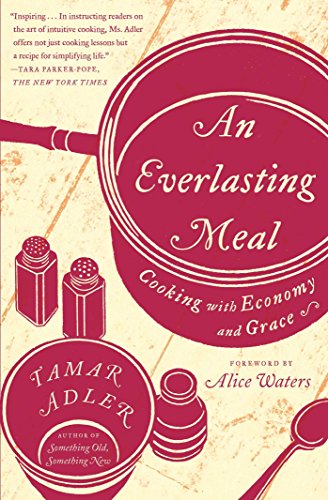
An Everlasting Meal: Cooking with Economy and Grace – via Amazon
But today, instead of setting things aside, I’m cooking it – all of it – one thing after another, often in the same liquids or roasting juices of the previous pan. With two months left on our CSA, I’ve been reading Tamar Adler’s book, “An Everlasting Meal,” and, as most home cooks who’ve read it would tell you, the way I use vegetables – actually the way I use almost everything in my kitchen – will never be the same.
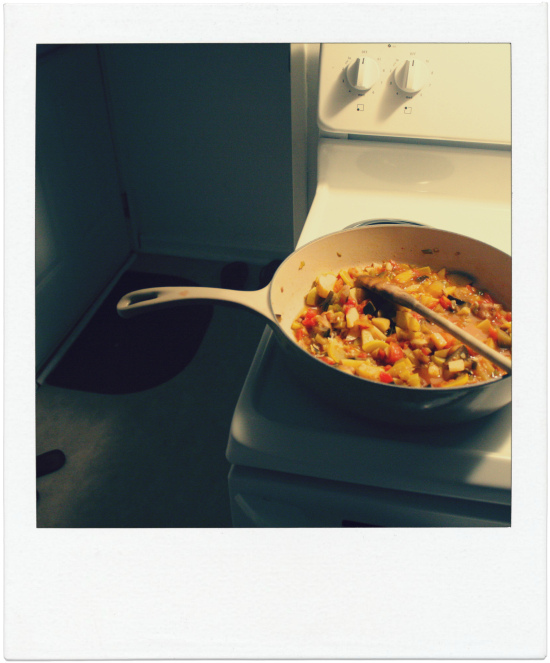
I first heard of Tamar Adler, and her book, in May, through an email from my friend Kendra. In the midst of what she called a “life-changing book,” Kendra was writing from her kitchen, where she’d just boiled vegetables, one right after another, in the same big pot, then layered them with leftover rice and roasted pork that “sent [her] through the roof in euphoria.”
All the scraps went right back into the same water, boiling steadily for about an hour, after which she took a sip so good, tears came to her eyes.
I didn’t know much about Tamar Adler back then, hadn’t read the New Yorker article she would later write about Julia Child, hadn’t caught when people like Tara from Tea & Cookies or Tracy from Shutterbean were talking about how wonderful she was.
All I knew, in May, reading a note from a friend, was that Tamar Adler’s way of using vegetables was so mind-blowing and beautiful that it could evoke tears of joy – and so I promptly clicked over to the Nashville Public Library system, became #54 or so in line and, waited.
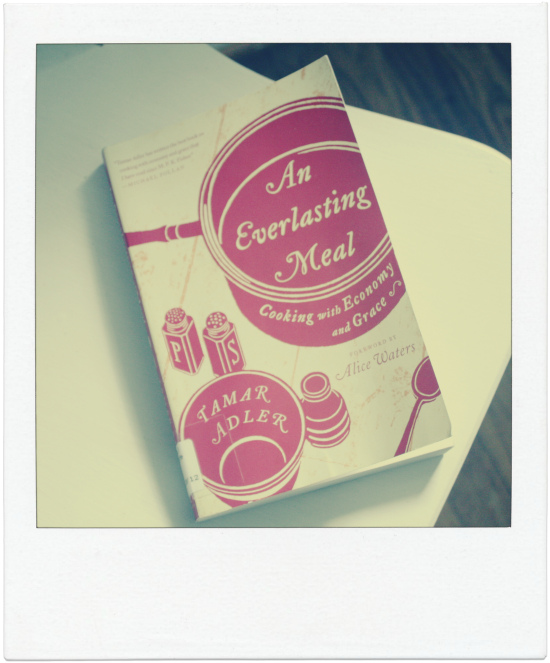
I started reading “An Everlasting Meal” less than two weeks ago, just before we went away for my birthday. I continued reading it on the seven-and-a-half-hour drive down, the three-hour drives to and from Louisiana, the seven-and-a-half-turned-nine-hour drive home.
Hearing Tamar’s advice is like talking to a woman who’s been cooking a long lifetime, filled with wit and wisdom gained from years of trying different techniques. She reminds me of my grandma, who knew foods so well, she didn’t have to consult recipes; and of Tim, who’s wowed me since we met with his ability to make a restaurant-worthy dinner when we have nothing in the fridge.
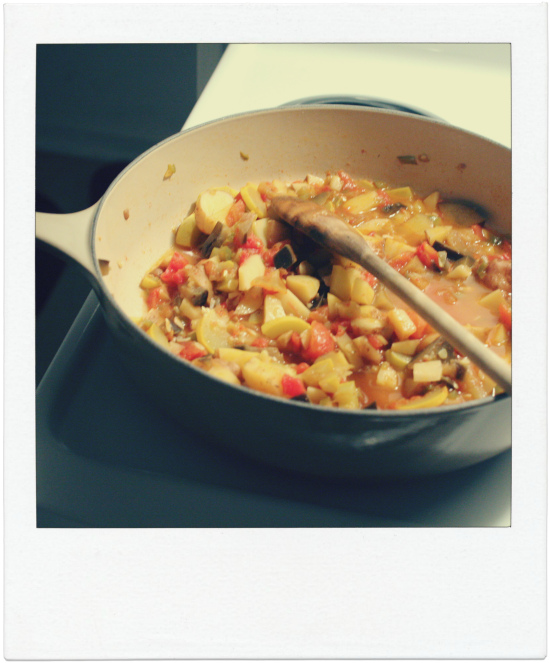
Tuesday in the kitchen, the outside light growing dim, once all my vegetables are washed and drying on a towel on our counter, I push trays of salted, chopped, oiled eggplant in the oven, alongside rounds of potatoes.
A pot goes on the stove to boil water for tomatoes, which get cored and skored with x’s on the bottom, plopped into water for eight seconds so their skins peel right off. Then into the same water go six or seven large potatoes, which I’ll eventually throw in the fridge to have when I need them (which turns out to be two days later, when I’m in a rush to a friend’s house for dinner and Tim and I throw together a potato salad).
Then, in my largest, deepest skillet, I warm minced garlic in olive oil and butter, adding half a green pepper, chopped.
Next goes all the diced eggplant that wouldn’t fit on my baking sheet to roast and some leftover chicken broth I poached eggs in that morning. I chop the three boiled tomatoes and add them next. Last are fingerling potatoes, diced smaller than I’ve ever diced them, so they’ll soften fully and well.
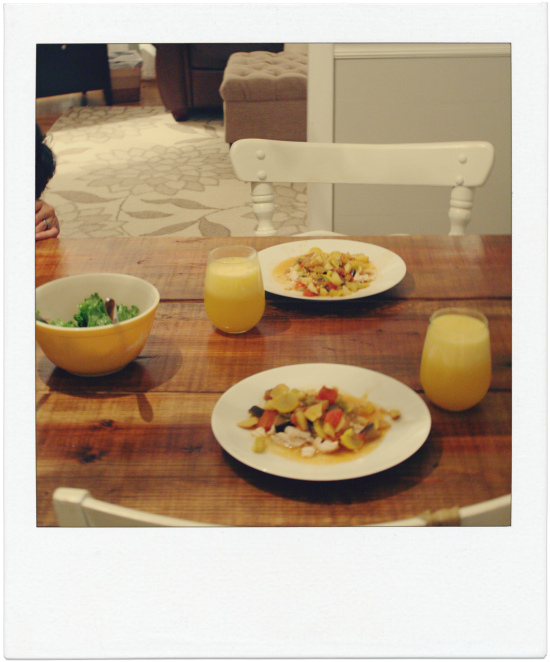
My husband, Tim, has been gone this whole time, at a work meeting, and when he arrives home two hours later, he steps into the kitchen with a smile on his face.
“Something smells good!” is how he greets me, and after he helps me clean up, after we salt and pepper the vegetables, then salt them again for taste, we dine on leftover roasted chicken topped with our slow-cooked vegetable hash, the fridge now packed with glass tupperware and mason jars filled with roasted eggplant and potatoes and green peppers and radishes and tomatoes – all of which will contribute to quick meals for the next few days.
Sitting across from him at the table, we take a few pictures in the chandelier light, join hands and shake our heads. This rustic spread before us, the combined byproduct of chicken broth (which I made from roasted chicken bones yesterday) and today’s CSA vegetables and a few hours of time, is, without question, one of the best meals we’ve enjoyed all week.
(And there’s more!) Once we’ve eaten our fill, the leftovers go into a mason jar in the fridge, providing us an intensely flavored mixture of vegetables now marinating in their own sauce, ideal for blending or eating again with pasta later on.
All of the odds and ends from chopping didn’t go into the trash but were saved in a pile to add to the water once the potatoes finish boiling. We cook them for hours until they’ve created a dark, rich, mineral-heavy vegetable broth now stored in our freezer.
The subtitle of “An Everlasting Meal” is cooking with economy and grace – and, right now, looking at our plates at dinner, the fridge stuffed with ready vegetables, stock boiling long on the stove, I want to cry with Kendra at how good and right and practical this all is.
Tamar Adler, reading your book has been the best kind of cooking school, such an education and a gift. I will be reading it for months and years to come. Thank you.
*And the magic continues:
To buy Tamar Adler’s book (which I just ordered despite my library borrow because this is a book to have on hand), click here for the hardback, softback and Kindle editions.
To create a similar dinner, you need less of a recipe and more of a willingness to try: the keys are long, slow cooking; layers of vegetables; and seasoning to taste. If you enjoy the results as much as we did, you’ll be satisfied indeed.
About Shanna Mallon
Shanna Mallon is a freelance writer who holds an MA in writing from DePaul University. Her work has been featured in a variety of media outlets, including The Kitchn, Better Homes & Gardens, Taste of Home, Houzz.com, Foodista, Entrepreneur, and Ragan PR. In 2014, she co-authored The Einkorn Cookbook with her husband, Tim. Today, you can find her digging into food topics and celebrating the everyday grace of eating on her blog, Go Eat Your Bread with Joy. Shanna lives in Nashville, Tennessee, with Tim and their two small kids.


Everyone I know who’s read this book has been transformed by it; a friend of mine living overseas loved it so much that she sent me one through Amazon. And in reading it myself, I had to go back over the very first chapter and start over again. It made that much of an impact on me. I don’t know when I’ve highlighted more, or underlined in such abundance as I did when reading this book.
Anything, I say, to get people cooking better, thinking more about their food and taking a bit more time to plan and enjoy what they eat. The best part about this book is how easy she makes it to nourish ourselves and our family. To anyone who’s ever gnashed their teeth over cooking, and how HARD it is, I tell them to get this book. No more excuses.
Well said, Kate, especially the part about nourishing—that is the perfect word.
I just finished “Dinner: A Love Story” last night thanks to your recommendation and I love love loved it, so now I will have to check this book out, too. Maybe it can help me get Murdo to eat his vegetables. 😉
p.s. where’d you get that rug in the living room? Love it!
Jacqui, it was such a miracle. we looked and looked for rugs, and specifically wanted one that was all wool, which is usually pretty pricey. then one night, I was surfing Target.com and found this rug on double-clearance. All together I think it was $175 or right around that, and it’s perfect for the room!
I’ll add this title to my list of books to read! It sounds amazing & I am eager to learn what I can about how to thoughtfully, healthfully, & economically feed our family. It’s an important responsibility that we too often sell out to our busy lifestyles. It’s time to slow down & get nourished 🙂
I’m glad you said that, MaryAnn—thoughtfully, healthfully and economically, indeed.
I just had to order the book after reading your review. I have thought about buying and reading it for quite some time now, and now I can wait to get it in the mail.
I also enjoyed the article Tamar Adler wrote for the New Yorker. Thanks for highlighting her book.
Yay! I would love to hear what you think after it arrives, Lena.
Yes! Love, love, love this book. I thought I had a decent background on cooking vegetables and all sorts of things, but Tamar is INSANELY resourceful. It’s been a total game changer in my kitchen. I can’t imagine my cooking life without this book now. So glad it’s come into your life too, lady.
She really is. I told Tim the other night that this has felt like a revolution to me—such a gift.
Fascinating! I will have to get this book! I was wondering if you have a suggestion about a brand of olive oil that is best. I usually buy what is on sale and I’m sure that isn’t the best method. Thanks.
Hi Kathy! Cold-pressed extra-virgin is best; unfiltered has the most nutrients, but just note that it’s more sensitive to heat. Also, organic is nice if you’re worried about pesticides. For what it’s worth, we most often buy a Spanish olive oil from Trader Joe’s that’s, I think, $8.99?
And when we’re cooking something at higher heats (above 375 degrees), we always use coconut oil because it’s more stable.
This is divine! We love our slow cooker and we’ll definitely try this recipe out. Bookmarking this page now!
Would love to hear your thoughts after you try it!
i have added this book to my ever growing to-read list.
this summer has been all about the csa stash, cooking them (either sauteed or boiled or roasted) and just putting them in bowl or plate, dressed simply and called The Pile. it’s been a godsend to not have to think so hard about meals but it’s something that was done daily, as opposed to all at once like you just did. while i understand the saving of time and resources (like using the same water & then eventually turning it into stock) what about not getting around to consuming everything that has been cooked? the food then goes untouched, eventually goes bad and then wasted. what then?
Hi Lan, Hmmm. Well, both raw foods and cooked ones will eventually go bad. You can freeze some cooked food easier than fresh; having it already cooked may make it easier to grab and eat it over the coming days; and also, you don’t have to do a huge CSA’s share each time. The point really is just that this is a strategy for making complete use of everything in the most graceful, economical way. (We still love our fresh, raw foods, too. And lacto-fermenting!) : )
I could not agree more. That book really made me think differently about food and meals and cooking. It’s amazing. I am not as skilled as Tim in the self-recipes but I’m working on it and this book definitely made it seem more attainable and easier. I’m trying to stop living and dying by recipes because after cooking consistently for so long it has to become innate at some point.
The chapter about eggs spawned my husband and I to create an omelette with some leftover summer corn and a marinated steak (from the freezer) with a lime crema sauce and fresh cherry tomato salsa. We were so very proud of it because we just looked at what we had and went from there.
I also borrowed from the library and have plans to buy immediately. I feel like an entire 2nd read-through is in order as well as constantly having it as a kitchen companion.
Kindred spirit! Love this comment, Elizabeth. Nodded my head and smiled all the way through it.
Well, clearly this makes me happy. I’m so glad you read it and loved it, and I also love that I have another “reserve it at the library” friend.
And the new header is awesome.
Kendra. Have I thanked you directly for recommending this book? THANK YOU FOR RECOMMENDING THIS BOOK. I can always count on you for real, authentic, helpful advice. The desire I have to cook side by side with you one day is only growing.
Another book to add to my must-read list, your words about it have really captivated me. And your photographs? Wow.
I’m so glad, Kathryn. It’s a keeper.
Requested it from the library (no wait!). Can’t wait to read it!
What luck! Hope you enjoy it as much as I have!
I’ve been meaning to read this book for a long time, and my number just hasn’t come up yet at the library. After reading your post I can’t wait much longer!
ha! oh, I so understand. There are so many books I want to read, it’s just wiser for our budget if I wait for the library… even when that means waiting looooong. : ) But in this particular case, the borrow only convinced me it was worth a buy.
This sounds amazing- both the book and the method. Will have to give it a try very soon with one of our CSA boxes.
Do it, Amy, and please tell me what you think!
I should begin by stating that I adore this book, but experienced a very different reaction to it than most. Essentially, I didn’t find her cooking methods entirely compatible with my lifestyle. If I came home after a long day of work and started boiling a pot of water with no idea what to put in it, I don’t think I would enjoy cooking as much as I do. It’s just not a practical way for me to prepare meals. I do cook this way when I have the time (like on weekends), but Monday-Friday, I’m a planner. Meals are decided ahead of time and I shop accordingly because that’s what my schedule allows. Her writing is alluring, and I do love the simplicity and economy of many of her recipes, though. I’m glad she wrote the book, glad to have read it, and no doubt will be returning to it. Just wanted to share another perspective though, because I’m not convinced this approach is for everyone. (And clearly I could go on an on about this, so Shanna, send me an email if you’d like to discuss further!)
Ha! I love that you shared your thoughts here, Nicole. Thank you! You raise some valid points about why this economical, thoughtful, more save-everything approach to cooking might not be practical for every lifestyle. I think these ideas could also feel overwhelming to a lot of people just because of all there is to know.
But like you, I still love the book, even taking those things into account, and for me that’s because there’s still real value to be gained from it. Even if just a widened perspective and a few more cooking tools in your arsenal, even if you don’t want to stop menu planning or recipe using or so on. It’s a way to have a little more confidence in knowing how to handle burned rice or vegetable scraps. It’s a way to gain understanding about what can be done with what. And personally, I also feel hopeful that these methods will grow with me over time: maybe right now I’m testing out the idea of roasting everything ahead of time, but maybe later the way I use Tamar’s principles will look different. Either way, she gives explanations and techniques I honestly have never had explained so well.
Would love to hear from other readers about their reactions (good or bad!) — thanks again, Nicole, for being unafraid to be honest!
Glad you didn’t think I was totally crazy! Sometimes I feel like the only one who had this reaction to her book. I do agree that there are some great tips, recipes, and I’ve certainly gained new insights from reading it. I just like to know what I’m putting in my pot before I boil it. 🙂
You are so right, I was given her book as a gift and thought I knew how to cook dried beans. What I ended up with I called OMG Beany-brothy deliciousness. Crazy good. Lovely post here.
What a good gift! And given to someone who would see the treasure it is!
Happy belated birthday, Shanna. If I had one cookbook in me, it would be all vegetables. I just was thinking of this yesterday as a friend of mine got a contract for savory pie, but he had never made pie before, but that’s what publisher wanted. It will be great because he is great, but how lovely to be cooking in your true element. I must rush to buy this book. Vegetables are the one food I cannot ever live without. I’ve lived without meat for two years without bread for long periods of time and without sugar, but vegetables are the earth’s best gift to us, and the way you presented this has my mouth watering.
Thanks, Angela! And I should add, although the vegetable sections were fast favorites for me, Tamar also gives plenty of attention to meat, talking about bone broths and roasts and fish and so on. So much great, helpful information!
That sounds delicious! I’ll definetly need to remind myself to add this book to my reading list.
After reading your post, I bought the book on Amazon and I’m loving it so far. Thanks!
Picked it up at the library yesterday. Hoping my children will actually let me read it!
Oh man, I have moved Tamar’s book from my bed stand in Oklahoma to my bed stand in Missouri and I still haven’t read past the first chapter. It’s time I get to it!!!
I could totally see why this could be a book that would take a while–it’s not a light read and I had to read a lot of the information more than once to understand it. But whether you keep it on your nightstand for another year or a few days, it’s worth getting to, at whatever pace works for you!